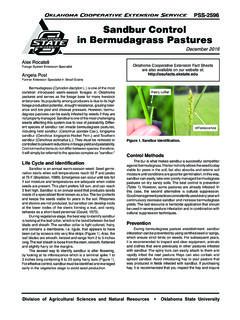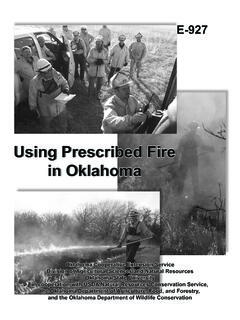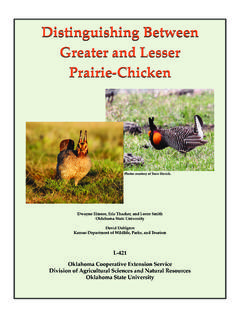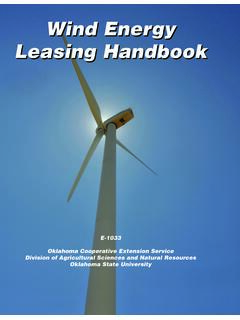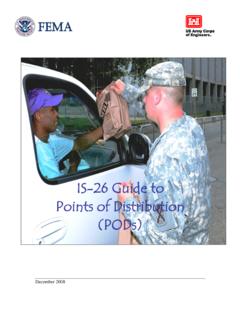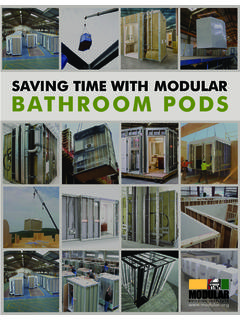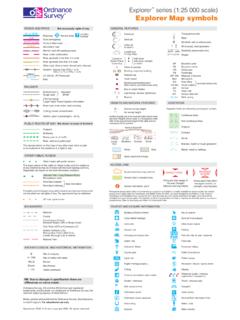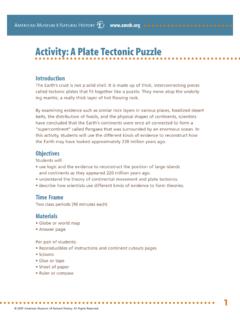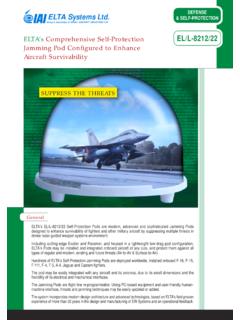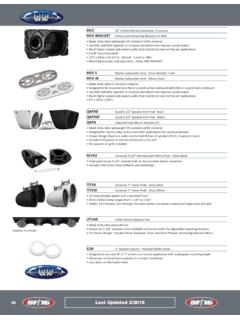Transcription of Home Vegetable Garden Insect Pest Control
1 Division of Agricultural Sciences and Natural Resources Oklahoma State UniversityEPP-7313 Oklahoma Cooperative Extension Fact Sheets are also available on our website at: RebekAssociate Professor and State Extension SpecialistHorticultural EntomologyDavid HillockAssistant Extension Specialist HorticulturePests vs. Beneficials Insects and mites are classified as pests based on their ability to damage plants and reduce yield. Many insects and most spiders found in home Vegetable gardens are beneficial and Control of these arthropods is not recommended. An introduction to beneficial insects and other arthropods of Oklahoma can be found in Oklahoma Cooperative Extension Service Publications EPP-7307: Beneficial Insects and E-1023: Conserving Beneficial Arthropods in Residential Pest Insects in the Home Garden Insects and mites can move into the Garden and rapidly increase in abundance.
2 Examine plants in and around the Garden at least twice weekly throughout the season, focusing on a few plants of each cultivar. Search under leaves, inside developing fruit, along stems, and at the plant base or crown. Note signs and symptoms of feeding damage such as Insect excrement, holes in leaves or fruit, and twisted or deformed leaves. Record the extent of damage from week to week to aid in determining whether insects and/or damage are Insects Identifying insects and other arthropods can be a daunting task, so become familiar with common pest species and use a hand lens with at least 10X magnification to aid in identification of very small specimens. Color photos and descriptions of the most common Insect pests are included in this fact sheet. Once the pest is properly identified, it can be classified by the type and amount of damage it the Damage Damage is classified by how and where pests feed.
3 Chewing damage - Insects with chewing mouthparts tear off plant tissue and chew it. Examples include beetles, caterpillars, and grasshoppers, which feed on fruit or leaves and often leave holes in affected plant tissue. These insects defecate on plants and soil, leaving behind excrement (frass) that may be brown, black, or green. Sucking damage - Insects with piercing-sucking mouth-parts insert their straw- or needle-like mouthparts into plant tissue and suck plant sap and other liquids. Examples include squash bugs, aphids, and stink bugs. Many insects that feed in this manner defecate a sticky liquid (honeydew) that often builds up on leaves or fruit, leaving a shiny residue that may support the growth of sooty mold. Damaged foliage will turn yellow and eventually become brown and necrotic or mal-formed. Thrips and mites also feed on plant juices, but their mouthparts differ slightly. Key Pests Pests that feed directly on the harvested portion of the plant are often the most destructive.
4 Hence, little tolerance is given for these key pests and they should be controlled when found in large numbers in the Garden . Examples include corn earworm and tomato fruitworm. Many insects and mites feed on leaves or on parts of the plants that will not be harvested. Most gardeners can tolerate low numbers of these in the Garden . They often serve a useful purpose because they attract and help maintain populations of predatory or para-sitic insects or mites that also feed on and Control key pests. You must decide how many of these pests you are willing to tolerate, keeping in mind that large numbers can cause leaf curl and other damage and reduce the vigor of your Garden plants. Examples include aphids and spider mites. A list of commonly grown vegetables and associated arthropod pests are provided in Table Pests Ideally, pests should be prevented from becoming a problem in the first place.
5 Pest problems can be prevented by selecting crops that are well adapted to the local climate and soil. Also, pests are kept in check by maintaining a healthy crop through cultural practices such as proper fertility and irrigation. Finally, prevent small infestations from becoming a major problem by removing pests early. Pest monitoring en-hances the success of early pest detection and elimination. If additional Control options are warranted, numerous strategies can be adopted. Often, the most effective Control is achieved by combining Control tactics. Additional information about maintaining Garden plant health can be found in Oklahoma Co-operative Extension Service Publications HLA-6013 Summer Care of the Home Vegetable Garden , HLA-6007: Improving Garden Soil Fertility, and HLA-6032: Vegetable Varieties for the Home Garden in Vegetable Garden Insect Pest ControlOklahoma Cooperative Extension ServiceEPP-7313-2 Table 1.
6 Commonly Grown Vegetables and Associated Asparagus beetle AphidsBeans Bean leaf beetles Aphids European corn borer Leafhoppers Corn earwormCole crops (broccoli, cauliflower, cabbage, collards, kale, mustard, turnips) Diamondback moth Cabbage looper AphidsCucurbit crops (cucumbers, melons, squash, pumpkins) Cucumber beetles Squash bug Aphids Spider mitesSweet Corn Corn earworm Armyworms Mites Seedcorn maggot Flea beetles European corn borer CutwormsTomatoes (peppers, eggplant, potato) Tomato fruitworm Hornworms Blister beetles Flea beetles Colorado potato beetle Aphids Spider mites Stick bugs Leaffooted bugs Leafhoppers CutwormsOkra AphidsOnion ThripsPeas Aphids Stink bugs LoopersSpinach Aphids Stink bugs LoopersLettuce Aphids Spider mitesCultural Control Vigorous, rapidly growing plants often outgrow pest damage.
7 Plant recommended cultivars and maintain fertile soil with proper pH and moisture to provide your Garden a means to outgrow pest damage. Sanitation - dispose of infested plant and trash materials that harbor pests, and cultivate the soil to expose and destroy pests dwelling there. Weed Control - keep the Garden border areas mowed and trimmed and cultivate the Garden to Control unwanted plants (weeds). Weeds can serve as hosts to insects that can move to Vegetable plants. Time your plantings - many Insect pests, including corn earworm and squash bug, are less numerous early in the season. An early planting of vegetables will often escape with little to no damage. Traps are devices that collect pests or cause them to congregate, such as flat boards lain on top of the soil. Check traps frequently and collect and destroy Insect pests contained in the traps.
8 Barriers serve to exclude pests from the crop and include the use of cutworm collars placed around the stem collar of young transplants to prevent cutworm damage. Other barri-ers include row covers made of transparent or translucent materials such as mesh that allows light and air to enter, but blocks insects. Typically, row covers are supported above the plants with hoop frames although light-weight woven covers can rest on the canopy. Mechanical removal - large Insect pests can be removed by hand whereas small, soft-bodied pests such as aphids or mites can be washed from plants with a directed stream of water. Two water wands specifically designed for this purpose are the Water Wand for Spider Mites and the Jet-All Water Wand (see Texas A&M Agrilife Extension Publication EEE-00006: Water Wands: High Pressure Water Spray Devices for Insect and Mite Control ).Biological Control Oklahoma gardens contain a large abundance and diver-sity of arthropod predators and parasitoids that attack many common Vegetable pests.
9 Examples include lady beetles, lacewings, and spiders. These beneficial arthropods are best used by preserving or augmenting their numbers. You can maintain a diverse and healthy Garden by not spraying the Garden unnecessarily with insecticides and by maintaining a diverse planting that provides sources of prey, nectar, and pollen (see E-1023: Conserving Beneficial Arthropods in Res-idential Landscapes). Beneficial insects can be purchased from suppliers and released in mass numbers, but this practice has not proven reliable in home gardens. Many insects are attacked by pathogens, reducing their reproductive capacity and/or killing them. Several fungal and bacterial pathogens are formulated as insecticides and available to homeowners. Natural disease outbreaks occur during periods of wet and humid Pesticides are materials that are applied directly to pests or their environment that will kill pests or otherwise disrupt their life cycles.
10 Insecticides are specifically designed to kill insects and many other arthropods. A list of insecticides can be found in Table 2. Insecticides sold commercially must be registered with the Environmental Protection Agency and the State of Oklahoma s Department of Agriculture, Food, and Forestry. The label attached to the insecticide container provides specific information on proper use, handling, and disposal of the insecticide. ALWAYS USE PESTICIDES ACCORDING TO LABEL INSTRUCTIONS (refer to EPP-7450: Safe Use of Pesticides in the Home and Garden ).Organic Pesticides Organic gardeners consider insecticides extracted from plants or derived from a naturally occurring source as suitable tor organic production. Examples of botanical insecticides include neem extracts and pyrethrum. Materials derived from other acceptable sources include insecticidal soaps, Vegetable and mineral oils, and sulfur dusts.



